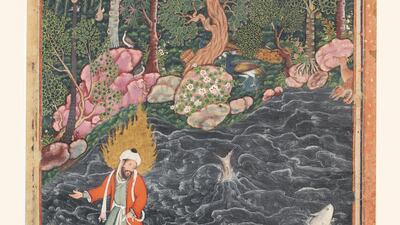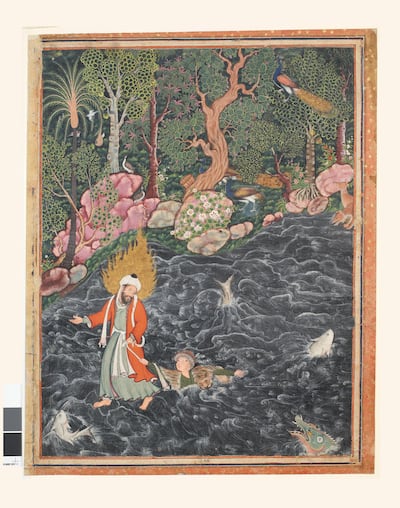An ambitious new gallery is set to open at the British Museum on Thursday, covering a vast stretch of the planet in the name of understanding Islam worldwide.
The Albukhary Foundation Gallery of the Islamic World is one of the London museum’s biggest projects yet, but may surprise visitors expecting a classic historical depiction of the religion. “It is not a gallery of Islam the religion, but it is a gallery of the regions in which Islam was the governing body at one point in time,” says Fahmida Suleman, one of the museum’s curators for the Modern Middle East.
As such, the items displayed may not be typically considered Islamic. They cover religions including Christianity, Judaism and Hinduism, continents from Europe to South-East Asia and topics such as games, music, painting and clothing.
The new gallery became a possibility with a cash injection from the Albukhary Foundation, a Malaysian charitable organisation dedicated to the preservation and study of Islamic culture. As well as sponsoring the new gallery in London, the organisation has been key in the creation of the Islamic Arts Museum Malaysia.
The once-in-a-lifetime opportunity for the museum curators – the chance to create a new gallery from scratch – came with a challenge particular to the British Museum as one of the great global repositories: what to leave out from the huge number of artefacts the museum owns.
Curators behind the project told The National during a tour of the gallery that they were not interested in simply redisplaying the artefacts kept in the museum's old Islamic gallery. They were aiming higher. "Once we knew that we were going to have this incredible space, we then got together to think about the stories we wanted to tell," said Venetia Porter, one of the curators on the project and an expert in Islam and the contemporary Middle East. "We saw this as an opportunity to tell a story of a very different geographical breadth, so from West Africa to Indonesia and China, from the 7th century to today."
The curatorial team drew inspiration from redisplays of existing works at the Metropolitan Museum of Art in New York and the Louvre in Paris, but also climbed down from the ivory tower and held focus groups with the public on what they would like to see displayed and how.
Armed with feedback on lighting, criticism of an overabundance of pots on display in the old gallery and a request for more information about Islam as a religion, the team set to work, and four years after the new gallery was first conceived, their ideas have been brought to life.
Spreading over two large rooms, the gallery runs chronologically through the centre display and thematically along the edges, with items in each case connecting with one another.
Architectural firm Stanton Williams played with light to give visitors a sense of place without risking light-damage to the displayed artefacts.
The firm created five new windows to bring lateral light into the space, but also to help visitors place themselves within the building and the city. And they created a system for letting light in from above, making the gallery the only place in the museum that visitors can see the sky while looking at the items displayed.
“We wanted to capture the spirit of the quality of light you get in Islamic architecture,” says Sanjay Ghodke, an associate at the company who worked closely with the curatorial team to bring the gallery to life.
Although the content of the gallery will remain relatively constant over its lifetime, enough changes are planned to keep regular guests engaged on every visit. Works on paper will change every six months and textiles every two years. A huge wall at the back of the second room will also be up for grabs for a rotation of curators to fill. It is currently occupied by a one-of-a-kind installation by artist Idris Khan, whose concrete memorial to the UAE's martyred soldiers, Wahat Al Karama, or "Oasis of Dignity", is on display outside Abu Dhabi's Sheikh Zayed Grand Mosque.

“The work of Idris Khan, a beautiful evocation of one of the rituals of Hajj, is an exciting departure for the Museum and a wonderful addition to the British Museum collection. Each one is made of words that come out from the central point of contact. It’s poetry, musings about his life,” says Porter, who chose it as a personal favourite. “What is amazing is the energy of it. When you stand back and look at it, you literally get that sense of the stone just launching, you really do.
“This is now a work that belongs to the British Museum and I feel really, really proud that we’ve done this, he was absolutely the right artist to choose.”
Khan’s work is not the only contemporary art in the gallery’s collection – in fact the Museum has also commissioned artist and designer Ahmad Angawi to create Mangour window screens in walnut wood to cover the gallery’s new windows.
The curators have also made a point of including modern artefacts in the thematic cases to tell the ongoing story of the Islamic World. This includes matchstick boats depicting the refugee crisis nestled in glass cases next to Khan's artwork at the end of the gallery.
“Our collection does not end yesterday, today or tomorrow,” says Zeina Klink-Hoppe, Phyllis Bishop curator for the Modern Middle East. “It’s a growing collection, and by having the contemporary included, responding to whatever is happening, it allows the collection to grow.”
Yet the past is not neglected and among the treasures is a set of ivory-carved book covers dating back to 14th century Egypt. “In people’s minds, we can’t have any figural representation in Islamic art, but it’s actually fine when it comes to secular objects,” says Amandine Merat, a project curator at the museum.
“Under the Mamluks, how people dressed was indicative of their status, and this is shown in the ivory fragments. Four of the figures bear different motifs on their clothing to indicate their roles within the palace and a fifth clutches a cross, indicating he is most likely a bishop.”
The musical tastes of people at various points of history and in various places is also well represented. A particular highlight is a lyre from Sudan. “I love this object because it’s like a coral reef. One amazing thing, but also a collection of amazing things that work individually,” says William Greenwood, Albukhary Foundation curator. “In the way that this whole gallery is about connections and the fact that the Islamic world is part of a much bigger world and about diversity and how things change, this sums it up for me.”
The Albukhary Foundation Gallery of the Islamic World at The British Museum opens on Thursday
____________________
Read more:
Louvre Abu Dhabi’s dynamic mission is shared at the Frankfurt Book Fair
Lebanon celebrates 2,000 years of creativity with new Nabu Museum
‘Solidarity’ and what it means in Palestine’s art scene
____________________




